TOYOTA MIRAI 2016 1.G Owners Manual
Manufacturer: TOYOTA, Model Year: 2016, Model line: MIRAI, Model: TOYOTA MIRAI 2016 1.GPages: 464, PDF Size: 8.05 MB
Page 91 of 464
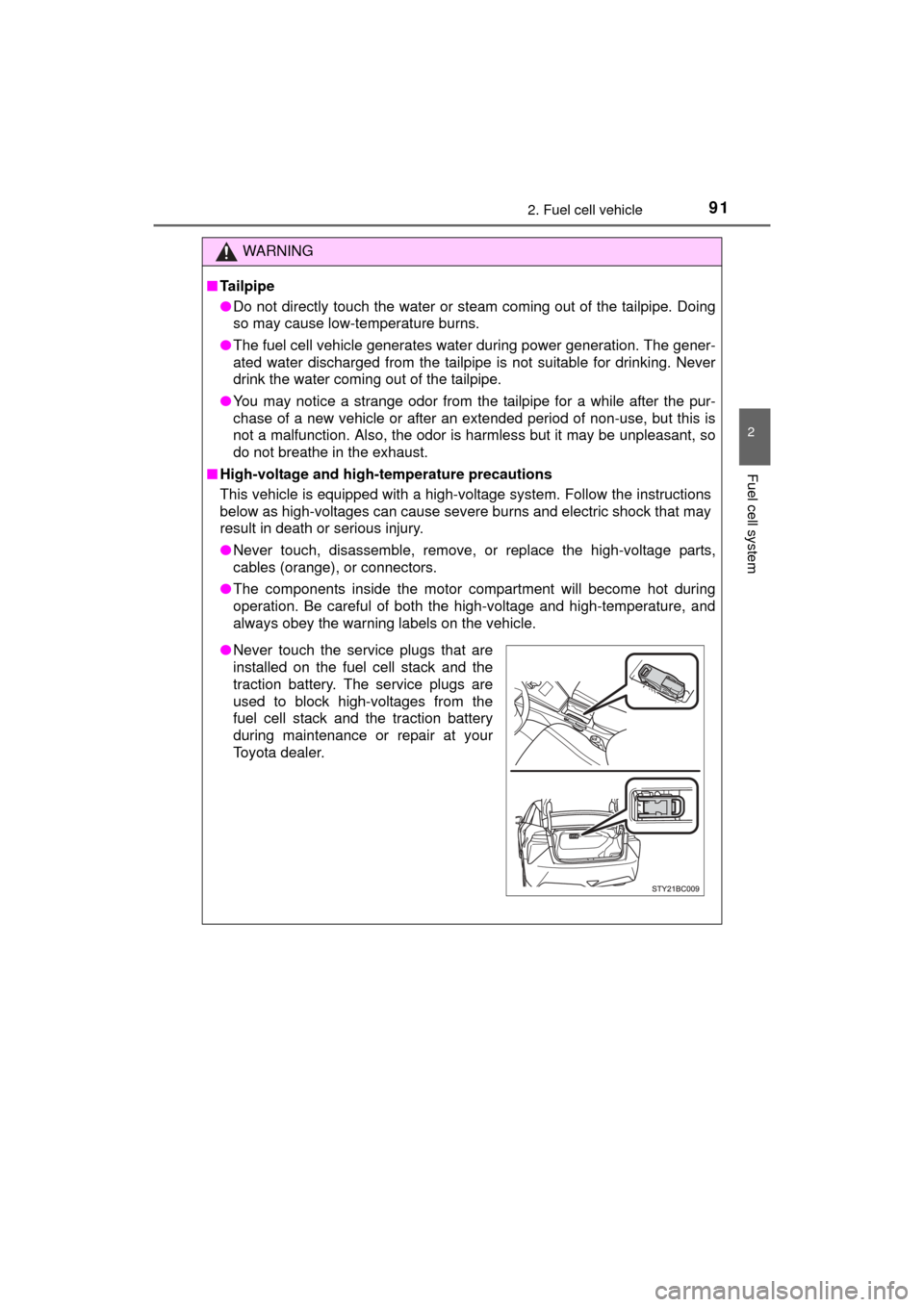
912. Fuel cell vehicle
2
Fuel cell system
MIRAI_OM_USA_OM62004U
WARNING
■Tailpipe
●Do not directly touch the water or steam coming out of the tailpipe. Doing
so may cause low-temperature burns.
● The fuel cell vehicle generates wate r during power generation. The gener-
ated water discharged from the tailpipe is not suitable for drinking. Never
drink the water coming out of the tailpipe.
● You may notice a strange odor from the tailpipe for a while after the pur-
chase of a new vehicle or after an extended period of non-use, but this is
not a malfunction. Also, the odor is harmless but it may be unpleasant, so
do not breathe in the exhaust.
■ High-voltage and high-temperature precautions
This vehicle is equipped with a high-voltage system. Follow the instructions
below as high-voltages can cause severe burns and electric shock that may
result in death or serious injury.
●Never touch, disassemble, remove, or replace the high-voltage parts,
cables (orange), or connectors.
● The components inside the motor compartment will become hot during
operation. Be careful of both the high-voltage and high-temperature, and
always obey the warning labels on the vehicle.
●Never touch the service plugs that are
installed on the fuel cell stack and the
traction battery. The service plugs are
used to block high-voltages from the
fuel cell stack and the traction battery
during maintenance or repair at your
Toyota dealer.
Page 92 of 464
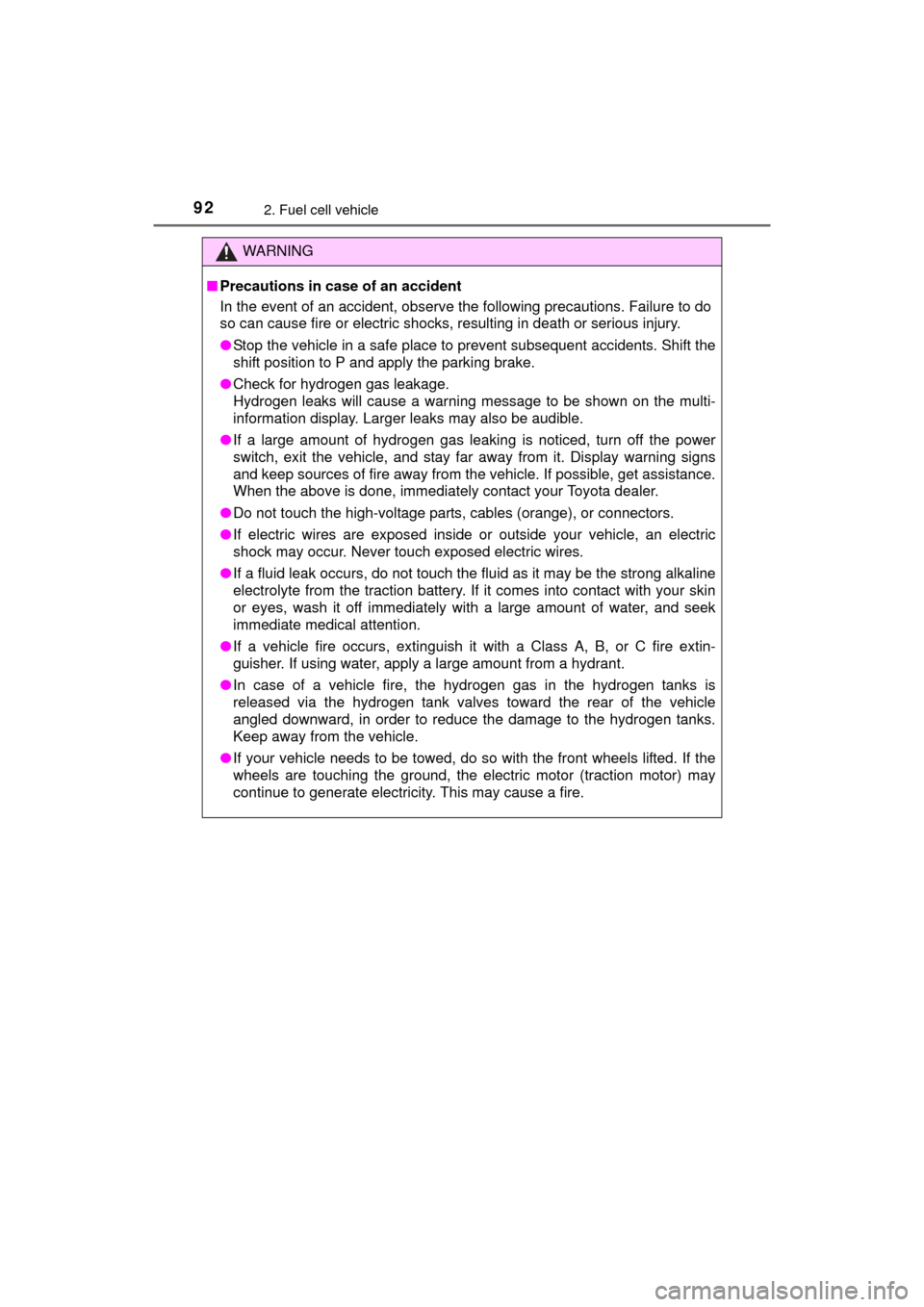
922. Fuel cell vehicle
MIRAI_OM_USA_OM62004U
WARNING
■Precautions in case of an accident
In the event of an accident, observe the following precautions. Failure to do
so can cause fire or electric shocks, resulting in death or serious injury.
●Stop the vehicle in a safe place to prevent subsequent accidents. Shift the
shift position to P and apply the parking brake.
● Check for hydrogen gas leakage.
Hydrogen leaks will cause a warning message to be shown on the multi-
information display. Larger leaks may also be audible.
● If a large amount of hydrogen gas leaking is noticed, turn off the power
switch, exit the vehicle, and stay far away from it. Display warning signs
and keep sources of fire away from the vehicle. If possible, get assistance.
When the above is done, immediately contact your Toyota dealer.
● Do not touch the high-voltage parts, cables (orange), or connectors.
● If electric wires are exposed inside or outside your vehicle, an electric
shock may occur. Never touch exposed electric wires.
● If a fluid leak occurs, do not touch the fluid as it may be the strong alkaline
electrolyte from the traction battery. If it comes into contact with your skin
or eyes, wash it off immediately with a large amount of water, and seek
immediate medical attention.
● If a vehicle fire occurs, extinguish it with a Class A, B, or C fire extin-
guisher. If using water, apply a large amount from a hydrant.
● In case of a vehicle fire, the hydrogen gas in the hydrogen tanks is
released via the hydrogen tank valves toward the rear of the vehicle
angled downward, in order to reduce the damage to the hydrogen tanks.
Keep away from the vehicle.
● If your vehicle needs to be towed, do so with the front wheels lifted. If the
wheels are touching the ground, the electric motor (traction motor) may
continue to generate electricity. This may cause a fire.
Page 93 of 464
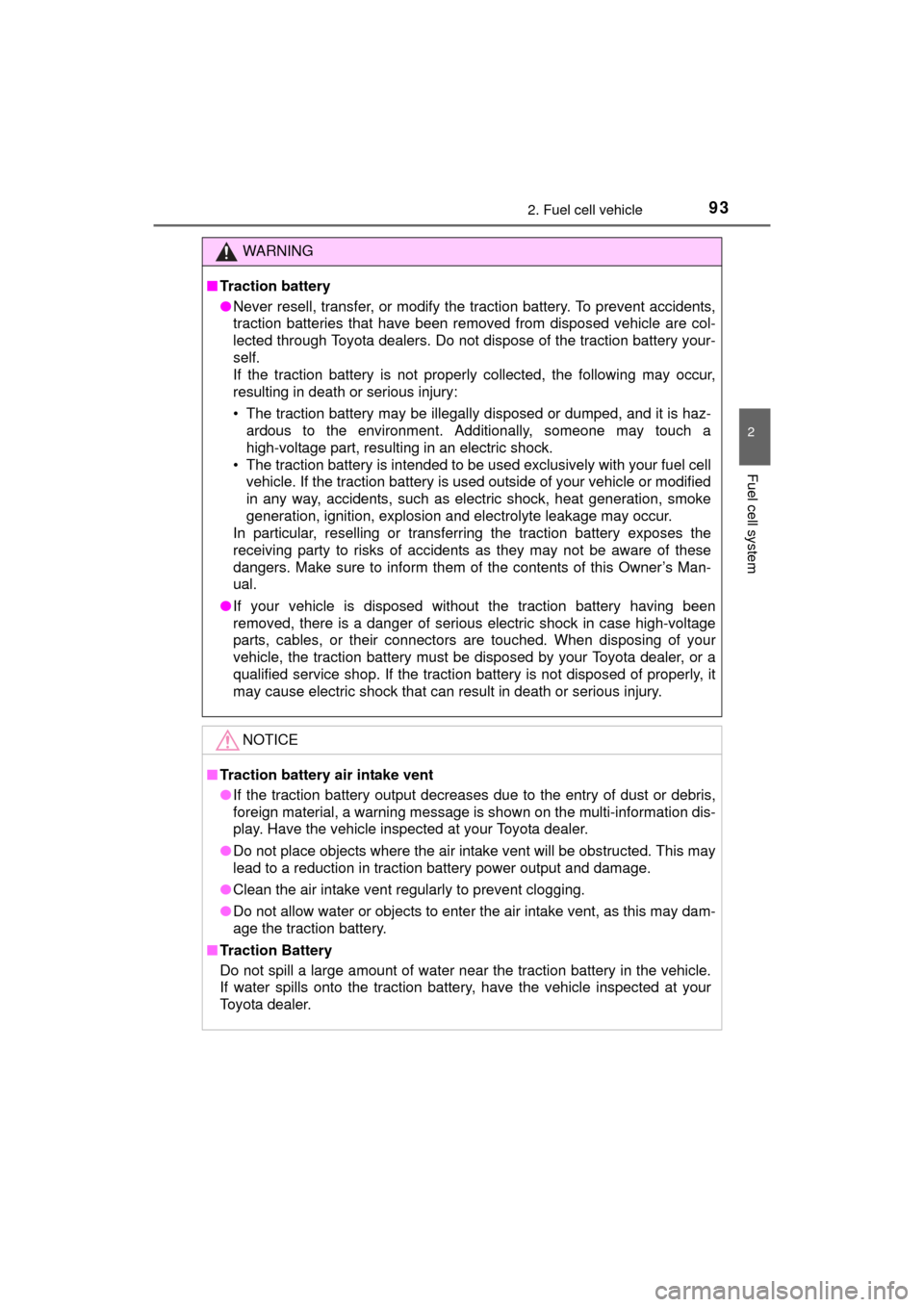
932. Fuel cell vehicle
2
Fuel cell system
MIRAI_OM_USA_OM62004U
WARNING
■Traction battery
●Never resell, transfer, or modify the traction battery. To prevent accidents,
traction batteries that have been removed from disposed vehicle are col-
lected through Toyota dealers. Do not dispose of the traction battery your-
self.
If the traction battery is not properly collected, the following may occur,
resulting in death or serious injury:
• The traction battery may be illegally disposed or dumped, and it is haz-
ardous to the environment. Additionally, someone may touch a
high-voltage part, resulting in an electric shock.
• The traction battery is intended to be used exclusively with your fuel cell vehicle. If the traction battery is used outside of your vehicle or modified
in any way, accidents, such as electric shock, heat generation, smoke
generation, ignition, explosion and electrolyte leakage may occur.
In particular, reselling or transferring the traction battery exposes the
receiving party to risks of accidents as they may not be aware of these
dangers. Make sure to inform them of the contents of this Owner’s Man-
ual.
● If your vehicle is disposed without the traction battery having been
removed, there is a danger of serious electric shock in case high-voltage
parts, cables, or their connectors are touched. When disposing of your
vehicle, the traction battery must be disposed by your Toyota dealer, or a
qualified service shop. If the traction battery is not disposed of properly, it
may cause electric shock that can result in death or serious injury.
NOTICE
■Traction battery air intake vent
●If the traction battery output decreases due to the entry of dust or debris,
foreign material, a warning message is shown on the multi-information dis-
play. Have the vehicle inspected at your Toyota dealer.
● Do not place objects where the air intake vent will be obstructed. This may
lead to a reduction in traction battery power output and damage.
● Clean the air intake vent regularly to prevent clogging.
● Do not allow water or objects to enter the air intake vent, as this may dam-
age the traction battery.
■ Traction Battery
Do not spill a large amount of water near the traction battery in the vehicle.
If water spills onto the traction battery, have the vehicle inspected at your
Toyota dealer.
Page 94 of 464
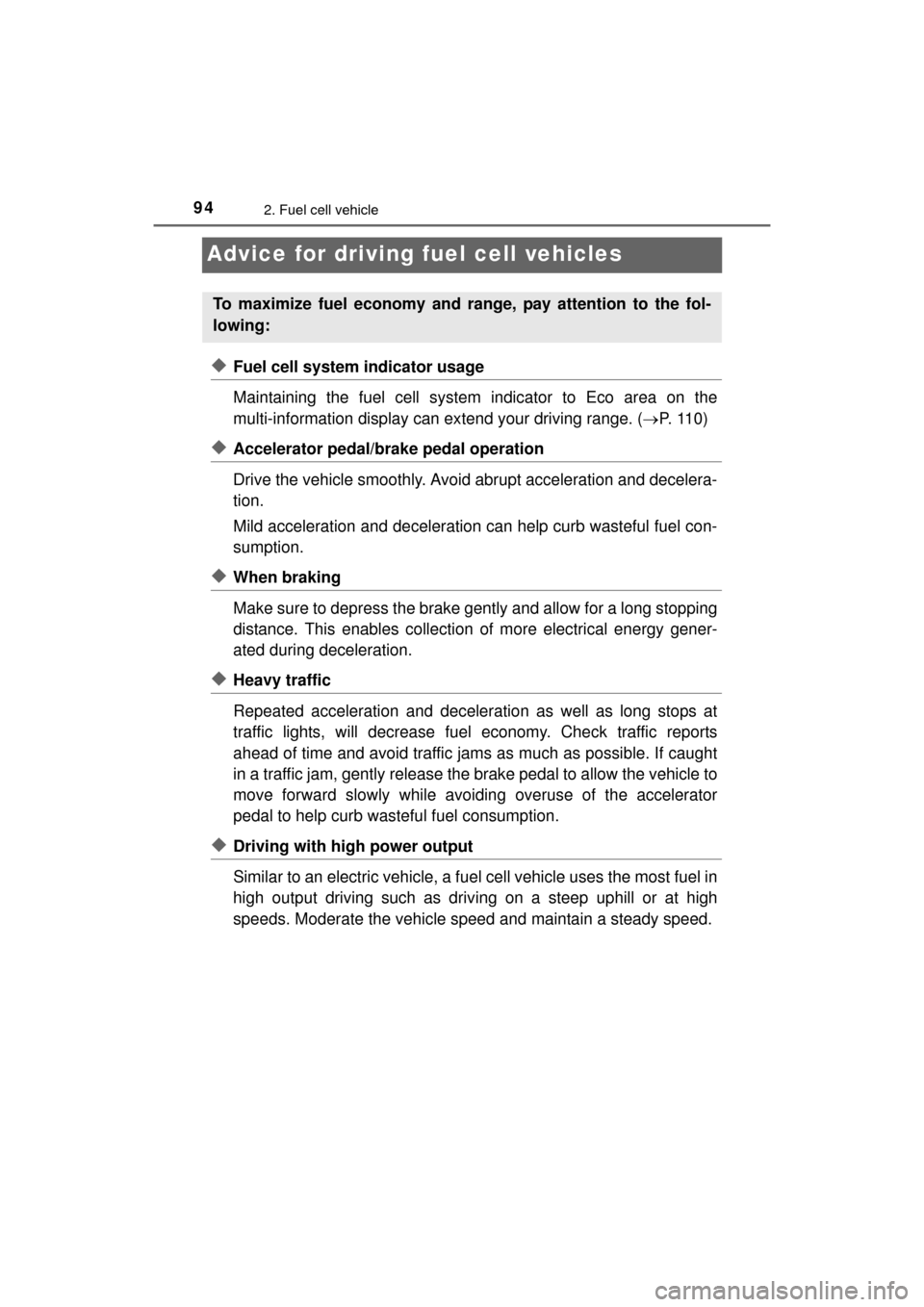
942. Fuel cell vehicle
MIRAI_OM_USA_OM62004U
Advice for driving fuel cell vehicles
◆Fuel cell system indicator usage
Maintaining the fuel cell system indicator to Eco area on the
multi-information display can extend your driving range. (P. 1 1 0 )
◆Accelerator pedal/brake pedal operation
Drive the vehicle smoothly. Avoid abrupt acceleration and decelera-
tion.
Mild acceleration and deceleration can help curb wasteful fuel con-
sumption.
◆When braking
Make sure to depress the brake gently and allow for a long stopping
distance. This enables collection of more electrical energy gener-
ated during deceleration.
◆Heavy traffic
Repeated acceleration and deceleration as well as long stops at
traffic lights, will decrease fuel economy. Check traffic reports
ahead of time and avoid traffic jams as much as possible. If caught
in a traffic jam, gently release the brake pedal to allow the vehicle to
move forward slowly while avoiding overuse of the accelerator
pedal to help curb wasteful fuel consumption.
◆Driving with high power output
Similar to an electric vehicle, a fuel cell vehicle uses the most fuel in
high output driving such as driv ing on a steep uphill or at high
speeds. Moderate the vehicle speed and maintain a steady speed.
To maximize fuel economy and ra nge, pay attention to the fol-
lowing:
Page 95 of 464
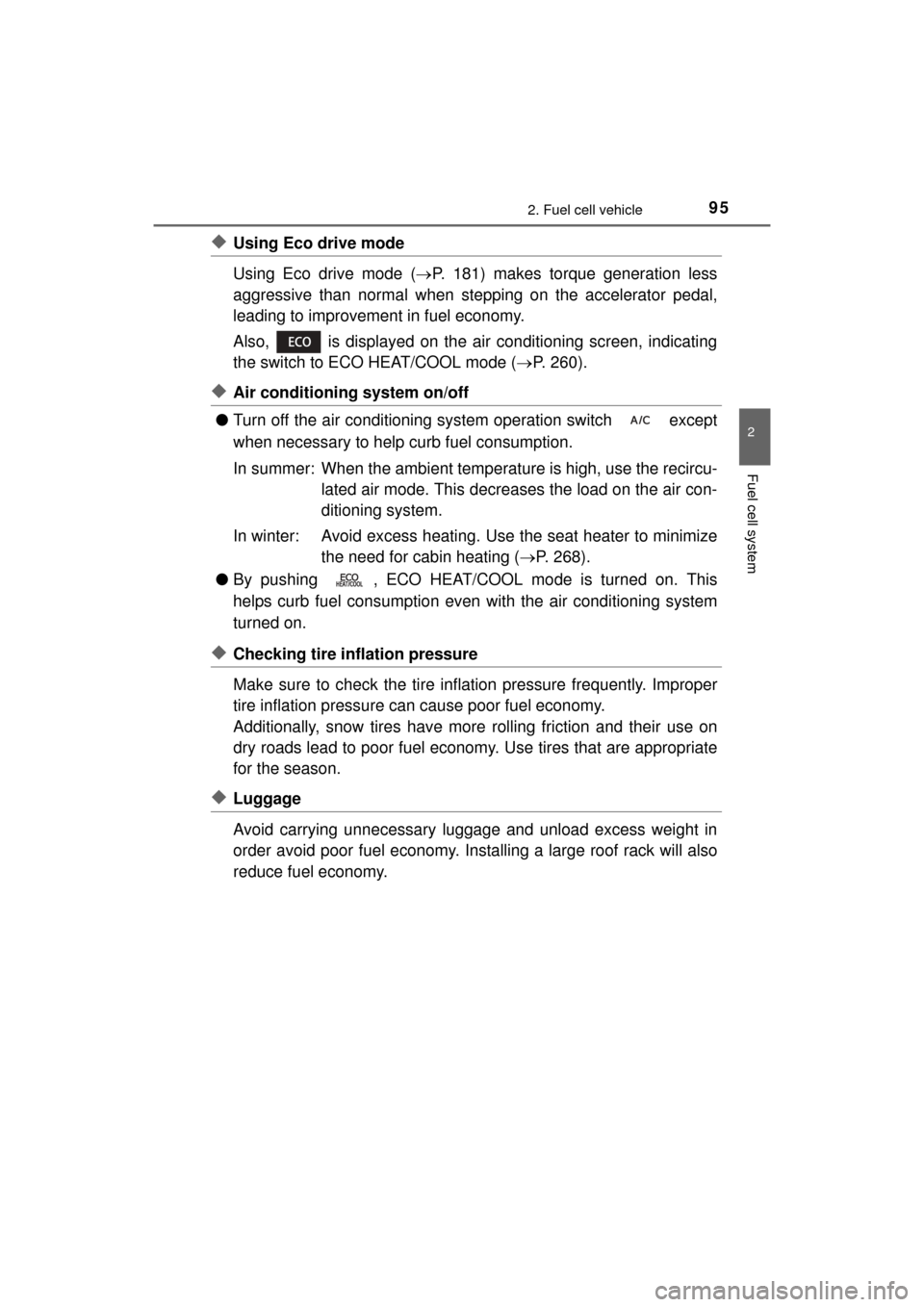
952. Fuel cell vehicle
2
Fuel cell system
MIRAI_OM_USA_OM62004U
◆Using Eco drive mode
Using Eco drive mode (P. 181) makes torque generation less
aggressive than normal when stepping on the accelerator pedal,
leading to improvement in fuel economy.
Also, is displayed on the air conditioning screen, indicating
the switch to ECO HEAT/COOL mode ( P. 260).
◆Air conditioning system on/off
● Turn off the air conditioning sy stem operation switch except
when necessary to help curb fuel consumption.
In summer: When the ambient temper ature is high, use the recircu-
lated air mode. This decreases the load on the air con-
ditioning system.
In winter: Avoid excess heating. Use the seat heater to minimize
the need for cabin heating ( P. 268).
● By pushing , ECO HEAT/COOL mode is turned on. This
helps curb fuel consumption even with the air conditioning system
turned on.
◆Checking tire inflation pressure
Make sure to check the tire infl ation pressure frequently. Improper
tire inflation pressure can cause poor fuel economy.
Additionally, snow tire s have more rolling friction and their use on
dry roads lead to poor fuel econom y. Use tires that are appropriate
for the season.
◆Luggage
Avoid carrying unnecessary luggage and unload excess weight in
order avoid poor fuel economy. Installing a large roof rack will also
reduce fuel economy.
Page 96 of 464

962. Fuel cell vehicle
MIRAI_OM_USA_OM62004U
Page 97 of 464
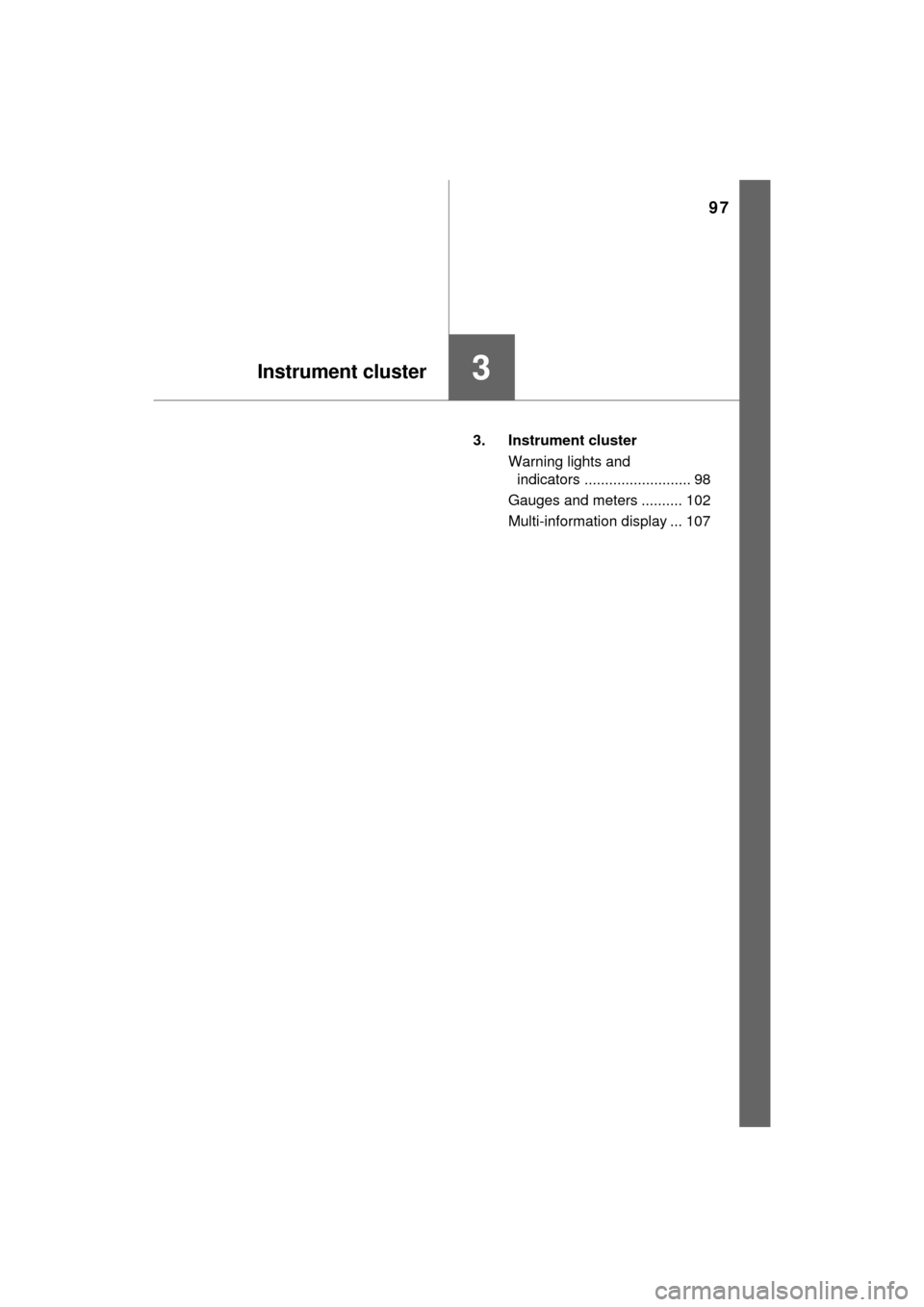
97
Instrument cluster3
MIRAI_OM_USA_OM62004U3. Instrument cluster
Warning lights and indicators .......................... 98
Gauges and meters .......... 102
Multi-information display ... 107
Page 98 of 464
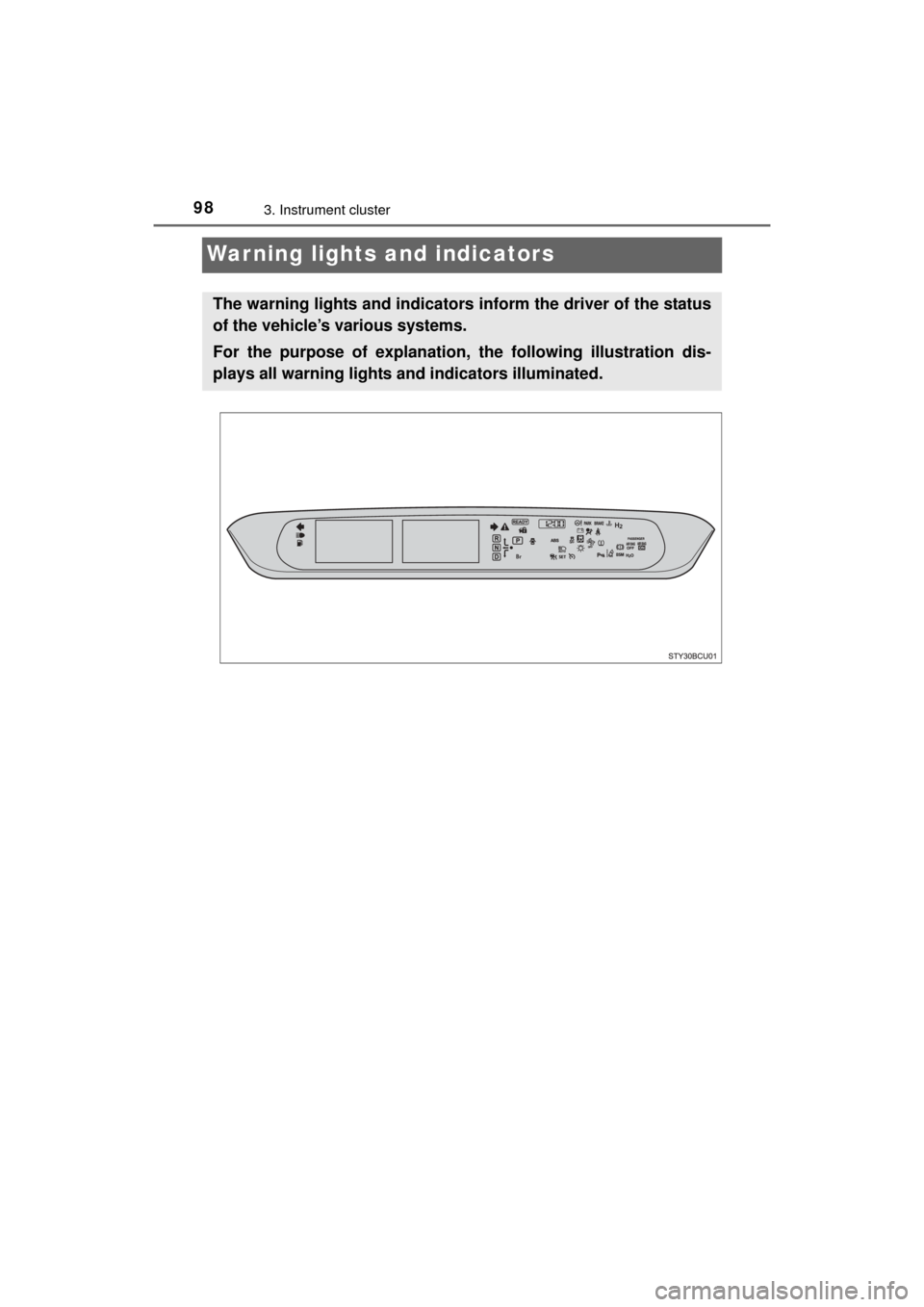
983. Instrument cluster
MIRAI_OM_USA_OM62004U
Warning lights and indicators
The warning lights and indicators inform the driver of the status
of the vehicle’s various systems.
For the purpose of explanation, the following illustration dis-
plays all warning lights a nd indicators illuminated.
Page 99 of 464
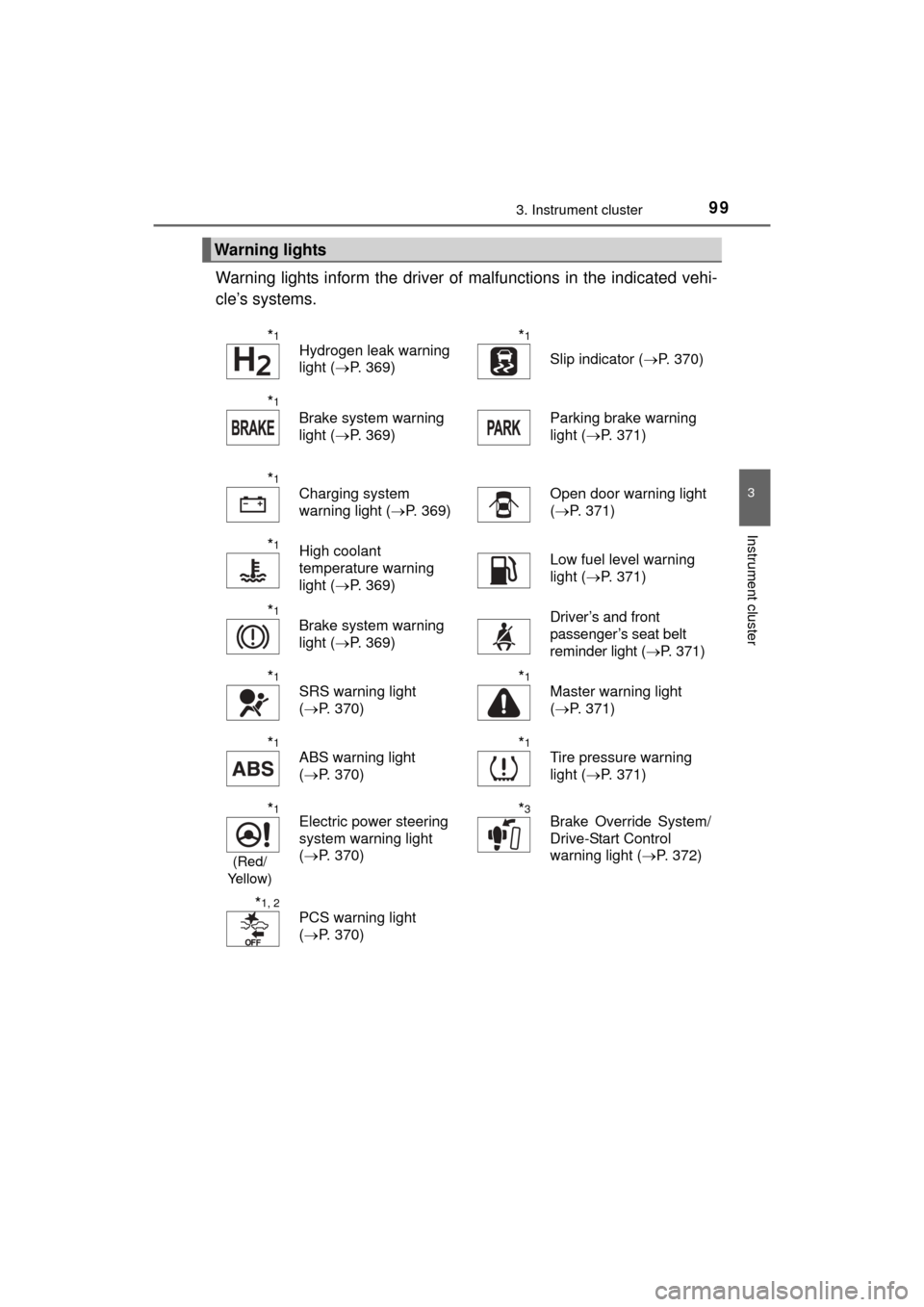
993. Instrument cluster
3
Instrument cluster
MIRAI_OM_USA_OM62004U
Warning lights inform the driver of malfunctions in the indicated vehi-
cle’s systems.
Warning lights
*1
Hydrogen leak warning
light ( P. 369)*1
Slip indicator ( P. 370)
*1
Brake system warning
light (P. 369)Parking brake warning
light (P. 371)
*1
Charging system
warning light ( P. 369)Open door warning light
(P. 371)
*1High coolant
temperature warning
light ( P. 369)Low fuel level warning
light (P. 371)
*1
Brake system warning
light (P. 369)Driver’s and front
passenger’s seat belt
reminder light ( P. 3 7 1 )
*1
SRS warning light
(P. 370)*1
Master warning light
(P. 371)
*1
ABS warning light
(P. 370)*1
Tire pressure warning
light ( P. 371)
*1
(Red/
Ye l l o w )
Electric power steering
system warning light
( P. 370)*3Brake Override System/
Drive-Start Control
warning light ( P. 372)
*1, 2
PCS warning light
(P. 370)
Page 100 of 464
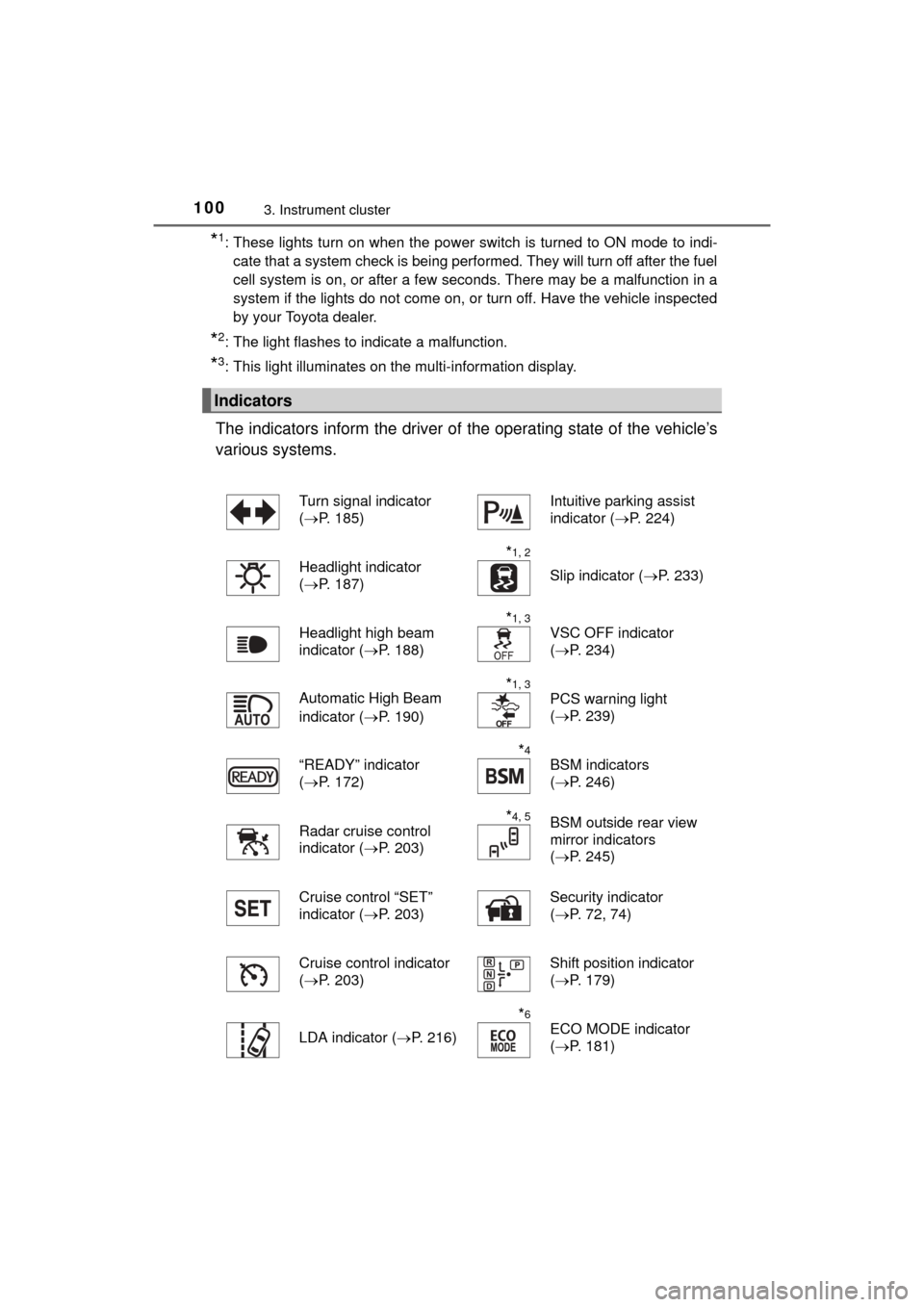
1003. Instrument cluster
MIRAI_OM_USA_OM62004U
*1: These lights turn on when the power switch is turned to ON mode to indi-cate that a system check is being performed. They will turn off after the fuel
cell system is on, or after a few seconds. There may be a malfunction in a
system if the lights do not come on, or turn off. Have the vehicle inspected
by your Toyota dealer.
*2: The light flashes to indicate a malfunction.
*3: This light illuminates on the multi-information display.
The indicators inform the driver of the operating state of the vehicle’s
various systems.
Indicators
Turn signal indicator
( P. 185)Intuitive parking assist
indicator ( P. 224)
Headlight indicator
( P. 187)
*1, 2
Slip indicator ( P. 233)
Headlight high beam
indicator ( P. 188)
*1, 3
VSC OFF indicator
(P. 234)
Automatic High Beam
indicator ( P. 190)
*1, 3
PCS warning light
(P. 239)
“READY” indicator
( P. 172)
*4
BSM indicators
(P. 246)
Radar cruise control
indicator ( P. 203)
*4, 5BSM outside rear view
mirror indicators
(P. 245)
Cruise control “SET”
indicator ( P. 203) Security indicator
(
P. 72, 74)
Cruise control indicator
( P. 203)
Shift position indicator
(P. 179)
LDA indicator ( P. 216)
*6
ECO MODE indicator
(P. 181)